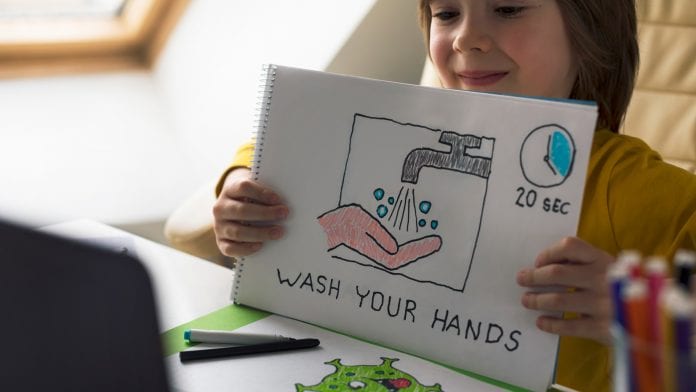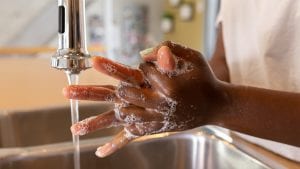
Dr Sophie Rutter of the University of Sheffield speaks to HEQ about how to promote handwashing to children.
As children in countries around the world begin to return to school following the easing of COVID-19 lockdown restrictions, their role as potential vectors of infection has become a point of concern, at least in part because children cannot always be relied upon to observe infection control measures. Hand hygiene is an integral facet of preventing and controlling the spread of infection; and hand hygiene messaging, where it is delivered effectively, can have a demonstrable benefit on the frequency and assiduity with which audiences wash their hands. Dr Sophie Rutter of the Information School at the University of Sheffield speaks with HEQ about her research into the promotion of handwashing to children.
What role does hand hygiene play in the prevention and control of infection, particularly during a global pandemic? What is the optimum hand hygiene routine?
I would like to refer you to other sources for this question: the World Health Organization (WHO), the UK government and the US Centers for Disease Control and Prevention (CDC) have all published comprehensive guides to handwashing.

What are the key benefits of instilling effective handwashing techniques in children, particularly as schools begin to reopen following lockdown measures?
Handwashing is a key strategy for protecting yourself and others against COVID-19. Children are just as likely as adults to catch COVID-19 – the symptoms they experience may be less severe, but they can still pass on the virus to their families and others. As children return to school, it is important that they do not spread COVID-19 within schools or to their family members.
Hand hygiene has long been thought of as an effective action to reduce risk of infection-related illness1. Children are prone to other infections (such as common colds) because their immune systems are still developing. This can lead to absenteeism, which affects the progress of children’s learning and puts pressure both on the school system and on parents who will need to take time off work.
Handwashing is habitual: it is something we do as a matter of routine. Habits formed in childhood tend to be retained for life. Another key reason why children are often the target of public health interventions of this nature is that children will be likely to promote handwashing to their families. In the longer term, it is crucial to remind children and adults of the need to continue with good hand hygiene practices. As we enter a post-COVID society and mandatory hand hygiene practices lessen (such as children no longer asked to wash hands in outside sinks before entering school), there remains a need to remind children of the continued importance of hand washing.

Which methods of communication are most effective in encouraging children to wash their hands? Are persuasive space graphics a key factor?
For the 123 Germ Free project we developed persuasive space graphics (PSG). In a similar way to nudging, PSGs encourage actions (handwashing in this case) and are integrated within an architectural environment (that is, they make use of architectural features in their design). We incorporated hand hygiene messages onto the soap dispenser, tap and hand dryer, as well as in the cubicle and surrounding areas.
PSGs attract attention: they are visually appealing; and the clever integration with the architectural environment stimulates interest and makes them memorable. By placing the graphics at the ‘point of decision’, they act as a reminder and encouragement to children to wash their hands in the place where they wash them. It is important to implement a combination of text and images when directing a message towards young children, who are typically still developing as readers.
We co-designed our PSGs with the input of around 80 schoolchildren. This was particularly important because it meant that we were able to develop PSGs that children thought would be effective. The children’s designs were very different from those usually seen in hand hygiene campaigns targeted at children: rather than instructions on how to wash, children in our study wanted messaging that informed them about germs and why they should wash their hands2.
The development of the PSG is a collaboration between representatives of three universities: Principal Investigator Dr Catherine Stones of the University of Leeds School of Design; Dr Colin Macduff from the School of Design at Glasgow School of Art; and Dr Sophie Rutter, of the Information School at the University of Sheffield. For more about the 123 project, please see our website: https://123germfree.co.uk/about-2/.
Practical classroom tasks, such Australia’s GlitterBug training programme, can also be an effective and memorable way to teach children about handwashing; and this is partly why, through the award of a new Arts and Humanities Research Council (AHRC) Follow-on Fund, we are working with teachers to develop new creative ways to extend the 123 concept into the classroom.
Are any types of messaging particularly ineffective or more likely to garner a negative response from children?
Children did report to us that instructional graphics or simple reminders were less relevant and useful than motivational messages, such as ‘germs can make you sick’ or ‘there are germs on your hands that you can’t see’. They were also clear in stating that messaging strategies had to be fun and engaging and reported a dislike for overly authoritative approaches such as images that featured adults, teachers or scientists instructing them what to do.
It is highly likely that the pandemic will have affected our attitudes to hand hygiene and hand hygiene messages. For example, messages that focus on social norms have previously not been as effective as other types of messages – such as reminders of the need for regular handwashing or messaging which details the risk of poor hand hygiene – but given the emphasis in COVID-19 campaigns of not spreading infections to others, this might have changed.
Overall, though, this is still a very open question. We do not yet know enough about the effect that messaging has on children’s actual handwashing practices as it is an under-researched area.
What methods did you use to assess the persuasiveness of different communication types?
Handwashing is very difficult to evaluate3; and it is particularly difficult to evaluate in schools for a number of reasons. There are ethical concerns with observing children in washrooms. Primary schools do not always have the requisite toilet environments to support the installation of digitally monitored soap dispensing units. Also, adults cannot easily blend into the school washroom environment; and so it is likely that children would change their behaviour in response to our presence. Handwashing is a social norm, so people say they have washed their hands when they have not.
We evaluated the PSGs in three co-design schools and at the premises of our project partner, Eureka! The National Children’s Museum4. To ensure a robust evaluation we performed multiple types of evaluations, including:
- Handwashing frequency: we measured soap consumption before and after installing PSG. We found that soap consumption increased in all settings after the PSG was installed.
- Handwashing quality: we worked with microbiologist Dr Margarita Gomez Escalada from Leeds Beckett University to assess the quality of children’s handwashing before and after installing PSG. We took prints of children’s finger pads and thumbs on agar plates, incubated these and then analysed them for the number of colonies. We found that children’s handwashing quality improved in the school settings after the PSG were introduced.
- We interviewed over 120 children and asked them about the persuasiveness of the designs. We found that the PSGs were effective in gaining children’s attention and that children understood and remembered the key messages in the toilet spaces.
- We interviewed teachers and cleaning staff for their views on PSG. Most teachers and cleaning staff strongly agreed that the 123 designs are effective in encouraging hand hygiene in children. The designs engaged children; and it is important for children to be reminded at the point of use.
References
- Curtis V, Schmidt W, Luby S, Florez R, Toure O, Biran A. (2011). Hygiene: new hopes, new horizons. Lancet Infect. Dis. 2011, 11, 312–321.
- Rutter S, Stones C, Macduff C. (2019). Communicating handwashing to children, as told by children. Health communication.
- Rutter S, Macduff C, Stones C, Gomez-Escalada M. (2021). Evaluating children’s handwashing in schools: an integrative review of indicative measures and measurement tools. International journal of environmental health research, 31(1), 1-19.
- Rutter S, Stones C, Wood J, Macduff C, Gomez-Escalada M. (2020). Effectiveness and efficiency of persuasive space graphics (PSG) in motivating UK primary school children’s hand hygiene. International journal of environmental research and public health, 17(7), 2351.
Dr Sophie Rutter
Lecturer in Information Management
University of Sheffield
www.sheffield.ac.uk/is/people/academic/sophie-rutter
This article is from issue 17 of Health Europa. Click here to get your free subscription today.
























